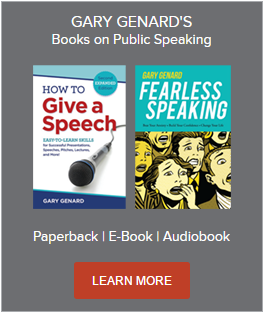Do you know how to pace your presentations for stronger presence? Here are 6 techniques to help you stay focused and connecting with your audience.
ad.ren.al.ine (epinephrine) 1. a hormone secreted by the medulla of the adrenal gland, that stimulates the heart, increases muscular strength and endurance 2. C9H13NO3 (Webster’s New World Dictionary, Second College Edition).
Ready to fight off that hostile tribe attacking your territory? To confront that saber-toothed tiger that's blocking the path? How about facing that audience in a high-stakes presentation?
In terms of evolution and your response to danger, your body's reaction is the same in all three situations. Your environment has suddenly become dangerous, and in response adrenaline is secreted into your bloodstream in the famous "fight-or-flight" response.
Read Chapter 7, "Twelve Easy Ways to Achieve Presence and Charisma" in my Public Speaking Handbook, How to Give a Speech. Discover 101 easy-to-learn skills. At Amazon.
Of course, a speech or presentation isn't really a dangerous situation. Yet the need to persuade, make a sale, or present yourself in the best light can certainly ramp up pressure and stress. In response, your body produces stress hormones. As a result, your speech rate increases dramatically, and the pace of your presentation can be thrown out of control.
Need to relax and get focused? Download my free cheat sheet, "How to Calm Your Nerves Before Speaking." It will take just 5 minutes of your valuable time!
The second worst thing about all of this is the feeling that you're off your game. The worst thing is the effect you know it's having on your listeners. A poorly paced presentation is difficult to absorb and respond to positively—which are the results you were hoping for from your audience but probably aren't achieving.
So what can you do to regain control? Here are 6 ways to use the situation at hand to speak more slowly and effectively. The great news about these approaches is that they will also improve your communication skills generally and boost your influence with audiences.
Do you suffer from speaking nerves? Want to test yourself to see? Take my Free "Stage Fright Quiz." Included is a chart that explains your score. So, stage fright? . . . Find out!
6 Ways to Speak Effectively for Stronger Presence
So relax, get set, and get back into the game:
- Invest yourself in your audience. Watch the body language, attentiveness, and comprehension of your listeners. See if you can notice how audience members are responding to what you’re saying. Here are my "Body Language Rules" for making sure your own nonverbal communication rocks!
- Breathe. Make sure you’re practicing diaphragmatic or “belly” breathing, including breathing more deeply and slowly. Speech anxiety can literally make you forget to breathe, so you find yourself gasping for air in the middle of your talk! Here's more on how breathing can help you control fear of public speaking.
- Learn to trust silence. Discover the power of the pause. Speeches and presentations need pauses for a number of reasons: to let important information sink in, to create anticipation, and for you to move between main points of your talk. Silence is one of the most powerful (and dramatic) speaking tools you own—don’t neglect it!
- Increase your rapport with listeners. Use inclusive language: “you” and “we” instead of “I” and “me.” For instance, rather than saying, “Here are 3 steps that should be taken to solve this problem,” say, “Let’s take a look at what we should do to solve this problem. I have some ideas, and I'm interested in hearing yours.” Mediocre presenters deliver information. Excellent speakers remind their listeners that together, they form a community sharing something of mutual value.
- In your practice sessions, tape yourself. The average American speaks around 140-160 words per minute. For the purposes of this exercise only, tape yourself speaking a two-minute portion of your speech, then transcribe what you said and count how many words were included. Get a sense of how far off you may be from the average speech rate. If you’re significantly fast, count out a maximum of 320 words and see if you can deliver them in two minutes with no time left over.
- Read some dense material out loud. Choose something that takes some explaining or a data-rich passage. Speak it out loud and tape yourself, as though you were talking to an intelligent but uninformed person on this topic. Did this slow you down? Were you an easier person to listen to on the tape while doing this exercise? If so, work on sounding closer to this person than the hyper-fast version of yourself.
Once you have your speaking rate under control, think about the other aspects of effective pacing: the order in which you introduce ideas, balancing the time you spend on each segment, how much time you take to answer questions, and the way you present information in terms of your audience's attention span. Here are 5 essential speaking techniques of leadership that can be of help.
Remember that people can usually pay close attention for only about 20 minutes before they need a change of some kind. Do you build in changes of pace in terms of both content and delivery? Think about it. But please, while you're doing it, relax.
Key takeaways from this article:
- Adrenaline will most likely cause you to speed up in presentations.
- By paying attention to your audience, you'll have lots more presence and charisma.
- Breathe diaphragmatically and build in pauses to get off the speed-track.
- Using inclusive language will also help you stay present and less stressed.
- Taping yourself is good training for slowing your speech rate down.
You should follow me on Twitter here.

Gary Genard is an actor, author, and expert in public speaking and overcoming speaking fear. His company, The Genard Method offers live 1:1 Zoom executive coaching and corporate group training worldwide. In 2022 for the ninth consecutive year, Gary has been ranked by Global Gurus as One of the World’s Top 30 Communication Professionals. He is the author of the Amazon Best-Seller How to Give a Speech. His second book, Fearless Speaking, was named in 2019 as "One of the 100 Best Confidence Books of All Time." His handbook for presenting in videoconferences, Speaking Virtually offers strategies and tools for developing virtual presence in online meetings. His latest book is Speak for Leadership: An Executive Speech Coach's Secrets for Developing Leadership Presence. Contact Gary here.
Photo credit: Michael McAuliffe on unsplash.com.





